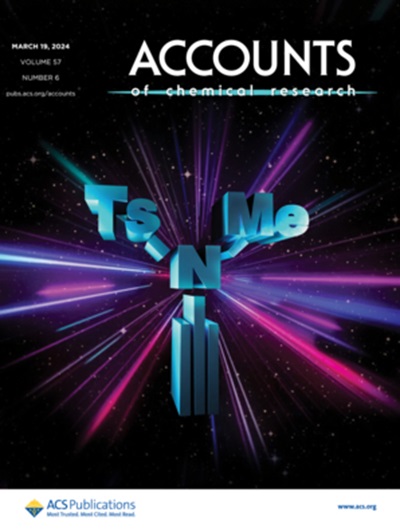Antioxidants: The Chemical Complexity Behind a Simple Word.
IF 17.7
1区 化学
Q1 CHEMISTRY, MULTIDISCIPLINARY
引用次数: 0
Abstract
ConspectusWhat does the word antioxidant mean? Antioxidants are supposed to be nontoxic, versatile molecules capable of counteracting the damaging effects of oxidative stress (OS). Thus, when evaluating a candidate molecule as an antioxidant, several aspects should be considered. Antioxidants are more than free radical scavengers. Other routes may contribute to their protection against OS, including modulation of the redox enzymatic system, preventing free radical formation, and repairing oxidized biomolecules. However, molecules intended as antioxidants can also exhibit pro-oxidant or toxic effects. Thus, understanding the full complexity of their chemistry is crucial for making reliable predictions about their activity.This Account focuses on computational tools that can assist in addressing such a challenging task. Some key aspects to consider when evaluating the potential antioxidant activity (AOX) of a molecule using these tools are (i) its absorption, distribution, metabolism, and excretion (ADME) properties; (ii) the effects of solvent and pH on its speciation and reactivity; and (iii) the toxicity of the molecule, its metabolites, and the products of the reactions it may undergo in vivo. While computational tools offer unique insights into the chemoprotective effects of antioxidants, care must be taken when assessing the data they produce. For example, reactivity descriptors alone are seldom enough to make reliable predictions on AOX. The thermodynamics and kinetics of the reaction pathways contributing to it frequently rule the antioxidant performance. The selected method of calculation should be reliable for the task at hand, since it influences the numerical outcome. Using some references for comparison allows adding context to the calculated data.We have developed two protocols that can be combined to include those aspects into computational studies of antioxidants: the Quantum Mechanics-Based Test for Overall Free Radical Scavenging Activity (QM-ORSA) and the Computer-Assisted Design of Multifunctional Antioxidants Based on Chemical Properties (CADMA-Chem). Some examples of the application of these protocols are discussed herein. They illustrate the diversity of reaction mechanisms and environmental conditions that modulate AOX, considering potential benefits and risks. These protocols provide a theoretical framework for investigating AOX that allows straightforward comparison with experimental results. They can be applied to known antioxidants for gaining insight into observed behavior as well as in the development of new antioxidants intended as potential drug candidates for the treatment of OS-related diseases.This work aims to promote comprehensive investigations into antioxidant chemistry, contribute to the interpretation of the results obtained from calculations, and encourage the development of safe, efficacious molecules that ameliorate the harmful effects of OS on human health.抗氧化剂:一个简单单词背后的化学复杂性。
“抗氧化剂”这个词是什么意思?抗氧化剂被认为是无毒的,多功能的分子,能够抵消氧化应激(OS)的破坏性影响。因此,当评估候选分子作为抗氧化剂时,应考虑几个方面。抗氧化剂不仅仅是自由基清除剂。其他途径可能有助于它们对氧化还原酶系统的保护,包括调节氧化还原酶系统,防止自由基形成和修复氧化的生物分子。然而,作为抗氧化剂的分子也可以表现出促氧化或毒性作用。因此,了解它们化学的全部复杂性对于对它们的活动做出可靠的预测至关重要。本帐户侧重于可以帮助解决这一具有挑战性的任务的计算工具。当使用这些工具评估一个分子的潜在抗氧化活性(AOX)时,需要考虑的一些关键方面是:(i)它的吸收、分布、代谢和排泄(ADME)特性;(ii)溶剂和pH对其形态和反应性的影响;(三)该分子的毒性、其代谢产物及其在体内可能发生的反应产物。虽然计算工具对抗氧化剂的化学保护作用提供了独特的见解,但在评估它们产生的数据时必须小心。例如,单独的反应性描述符很少足以对AOX做出可靠的预测。反应途径的热力学和动力学决定了其抗氧化性能。所选择的计算方法应该对手头的任务是可靠的,因为它会影响数值结果。使用一些引用进行比较可以为计算数据添加上下文。我们已经开发了两种方案,可以结合起来将这些方面纳入抗氧化剂的计算研究:基于量子力学的总体自由基清除活性测试(QM-ORSA)和基于化学性质的多功能抗氧化剂的计算机辅助设计(CADMA-Chem)。本文讨论了这些协议的一些应用实例。考虑到潜在的利益和风险,它们说明了调节AOX的反应机制和环境条件的多样性。这些协议为研究AOX提供了一个理论框架,可以直接与实验结果进行比较。它们可以应用于已知的抗氧化剂,以了解观察到的行为,也可以用于开发新的抗氧化剂,作为治疗os相关疾病的潜在候选药物。这项工作旨在促进对抗氧化化学的全面研究,有助于解释从计算中得到的结果,并鼓励开发安全、有效的分子,以改善OS对人体健康的有害影响。
本文章由计算机程序翻译,如有差异,请以英文原文为准。
求助全文
约1分钟内获得全文
求助全文
来源期刊

Accounts of Chemical Research
化学-化学综合
CiteScore
31.40
自引率
1.10%
发文量
312
审稿时长
2 months
期刊介绍:
Accounts of Chemical Research presents short, concise and critical articles offering easy-to-read overviews of basic research and applications in all areas of chemistry and biochemistry. These short reviews focus on research from the author’s own laboratory and are designed to teach the reader about a research project. In addition, Accounts of Chemical Research publishes commentaries that give an informed opinion on a current research problem. Special Issues online are devoted to a single topic of unusual activity and significance.
Accounts of Chemical Research replaces the traditional article abstract with an article "Conspectus." These entries synopsize the research affording the reader a closer look at the content and significance of an article. Through this provision of a more detailed description of the article contents, the Conspectus enhances the article's discoverability by search engines and the exposure for the research.
 求助内容:
求助内容: 应助结果提醒方式:
应助结果提醒方式:


